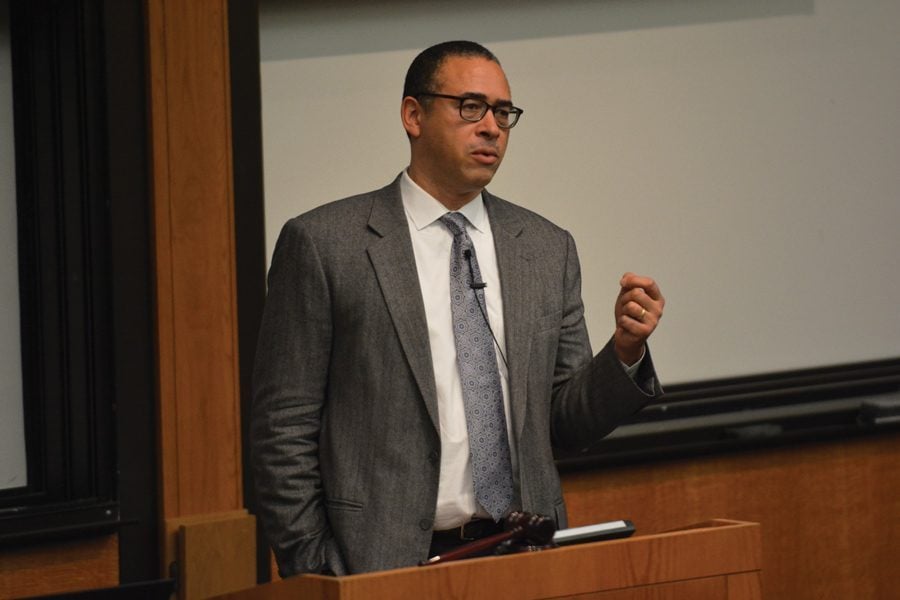In interview, Provost Holloway lays out academic vision of interdisciplinary collaboration
Daily file photo by Katie Pach
Jonathan Holloway. The provost laid out his academic vision for the school.
April 24, 2019
On April 22, three members of The Daily’s editorial board sat down with Provost Jonathan Holloway. Jeri Ward, the vice president for global marketing and communications, also sat in on the meeting. Holloway talked about his academic vision and diversity and inclusion initiatives. His answers have been edited for clarity and brevity. Small portions of the interview have been excluded from this transcript that have been withheld for future Daily articles.
The Daily: What academic vision are you promoting?
Holloway: The academic vision relates to the fact that when you’re thinking about Northwestern, you need to think about it as a sort of community of ideas and scholars. It’s an academically rigorous environment with a lot of engaged scholars and their hallmark is a lot of interdisciplinary work — not exclusively though. So, I’m in charge of answering the question: what’s my academic vision? I spoke to all of the deans — because they’re the ones who set the vision locally — and I asked, what are the things that are most important to you? And overwhelmingly, they were talking about a vision that is not just about “we’re going to support these five departments and let the other ones kind of fall by the wayside,” nothing like that. But it’s to recognize that we’ve got some amazing, cutting-edge departments that we need to support.
We’re on the cusp of joining that top ten by these crude rankings. We’ve got to find a way to boost them into that space. We are not going to be a one-note or three-note kind of school. If you look at the top fifteen schools, we’re all very similar in that we’re all committed to a full-range liberal arts education in areas that are very much what I’ll call, crudely, heavy return-on-investment areas, like engineering, or areas where you have a lot of time to rise into in the future, like history or philosophy.
We’re like all these other universities in that regard, but we are different, because we’re so deeply interdisciplinary and that’s what the crux of the vision is. The only school that comes close is (the University of Pennsylvania), and that’s because they have these professional schools. The academic vision is about pursuing excellence in lots of different ways and focus(ing) on interdisciplinary ideas, because I think that’s where we’ll find the answers to the most complicated ideas.
What also distinguishes us is that — and Penn joins us in this — is that there’s a mix of theory and practice. Coming from Yale, Yale is a very theory-based school — in some components there’s applied education, but it’s a shadow compared to what Northweestern does. So it’s recognizing those things that set us apart and proceeding down that pathway.
The Daily: How has Northwestern improved its diversity and inclusion in your time here and what areas are in need of the most attention?
Holloway: That’s a tough one to answer, because a lot of these issues related to diversity and inclusion are so complicated. To say we’ve made radical change in 18 months would be a bit silly, so I don’t want to overclaim. The other complication there is that (Chief Diversity Officer) Jabbar Bennett commissioned, with my approval, external consultants to come in to be an outside set of eyes and ears. They’ve spent six to nine months talking to a whole bunch of different people, trying to learn what their understanding of what the University’s vision of commitment to D&I looks like. And that report is going to be in my hands within a month’s time, so we’ll know a lot more then about how the office sees the vision going forward.
However, in terms of things we have done, the Staff Engagement Survey is done, students satisfaction survey, you have the black student educational task force — a lot of these things are sort of coming together now, and so we’re gonna know a lot more about things we need to do going forward. And that I see as progress, certainly.
The Staff Engagement Survey — it depended on where you were in the University – but certainly a portion of it discussed diversity and inclusion as an issue that needs to be addressed. One of the main ways to address those areas of concern is to make sure that staff — staff get all types of training on these issues — they want to make sure management gets the same, appropriate vision and training on how to manage staff on these issues. And staff want to make sure they have a voice in the process, so they aren’t powerless when it comes to articulating frustrations, or even good things, relating to D&I. And that’s something I’m definitely committed to — making sure the staff voice is being heard.
Email: [email protected]
Twitter: @birenbomb


